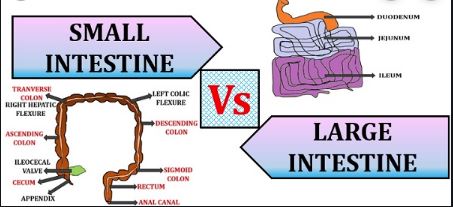What is Difference Between Small and Large Intestine?
Small vs Large Intestine
 Difference Between Small and Large Intestine is that In humans, the small intestine is about 6 meters or 20 feet long but the large intestine is about 1.5 meters or 5 feet, and the intestine resembles very long sets of hollow tubes that are folded several times so that they can be placed inside the abdomen.
Difference Between Small and Large Intestine is that In humans, the small intestine is about 6 meters or 20 feet long but the large intestine is about 1.5 meters or 5 feet, and the intestine resembles very long sets of hollow tubes that are folded several times so that they can be placed inside the abdomen.
The intestine extends from the stomach to the anus, water and nutrients are mostly absorbed in the intestine, nutrients in the small intestine, and water in the large intestine.
Key points of the Difference Between Small and Large Intestine
- The small intestine is longer than the large intestine.
- Generally, the width or diameter of the small intestine is smaller than that of the large intestine.
- Almost all parts of the small intestine except the duodenum are mobile. In contrast, many parts of the large intestine lack mobility.
- The caliber of the filled small intestine is smaller than that of the filled large intestine.
- The small intestine has a mesentery that descends through the midline into the right iliac fossa, unlike the large intestine.
- The large intestine has fatty tags attached to its wall called ‘appendages epiploicae’, unlike the small intestine.
- The outer wall of the small intestine is smooth while that of the large intestine is sacculate.
- The longitudinal muscle of the small intestine forms a continuous layer around it, while that of the large intestine (except the appendix) is reduced to form three bands called “taniae coli”.
- The mucous membrane of the small intestine has villi that are absent from the large intestine.
- The inner lining of the small intestine has permanent folds called circular plicae, whereas none of these folds are inside the wall of the large intestine.
- Payer’s plaques (aggregations of lymphoid tissue) are present only in the mucous membrane of the small intestine while they are absent in the large intestine.
- The small intestine is located between the stomach and the large intestine, while the large intestine is the last part of the gastrointestinal tract.
- The basic function of the small intestine is to digest food and absorb nutrients, while that of the large intestine is to reabsorb certain substances from undigested food and eliminate waste products.
About the small intestine
It is classified into three parts, the duodenum is the first, and the second jejunum and ileum last part, when food enters the duodenum, the pancreas secretes enzymes to help break down fat, protein, and carbohydrates. The bladder produces the gallbladder, produced by the liver, to help further break up fat into a form that can be absorbed by the intestine.
The small intestine is lined with finger-like projections, called villi, which provide a very large area to facilitate the absorption of nutrients, including carbohydrates, proteins, and fats, into the bloodstream, and the small intestine plays a key role in regulating blood sugar levels. A number of receptor cells detect the presence of macronutrients and secrete hormones that direct the pancreas on how much insulin and glucagon should be released. The duodenum is the first part of the small intestine which is also the shortest (about 25 cm, or about 10 inches).
About the large intestine
It is about 5 feet large, and two inches in diameter, the large intestine is where most water absorption occurs, when water is absorbed, it leaves behind an undigested part of the food, known as feces, and when the stool enters the rectum, the nerves are sent In that area pulses to the brain making an urge to defecate.
Most of the large intestine is located in the abdomen, the sigmoid colon, and the rectum in the pelvic cavity. The abdominal part of the large intestine includes the cecum and the ascending, transverse and descending colon. The main function of the large intestine is the absorption of water from the stool material before disposal from the body, the colon is also home to bacteria Friendly that synthesizes vitamin K and keeps bad microbes under examination.
You May Also Interested:
